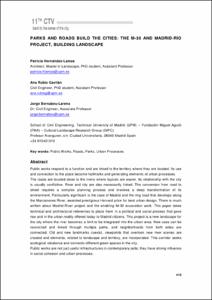Mostra el registre d'ítem simple
Parks and roads build the cities: the M-30 and Madrid-Río project, building landscape
| dc.contributor.author | Hernández-Lamas, Patricia |
| dc.contributor.author | Rubio Gavilán, Ana |
| dc.contributor.author | Bernabeu-Larena, Jorge |
| dc.date.accessioned | 2016-10-24T13:12:33Z |
| dc.date.available | 2016-10-24T13:12:33Z |
| dc.date.issued | 2016-07 |
| dc.identifier.citation | Hernández-Lamas, Patricia; Rubio Gavilán, Ana; Bernabeu-Larena, Jorge. Parks and roads build the cities: the M-30 and Madrid-Río project, building landscape. A: Virtual City and Territory. "Back to the Sense of the City: International Monograph Book". Barcelona: Centre de Política de Sòl i Valoracions, 2016, p. 415-428. |
| dc.identifier.isbn | 978-84-8157-660-3 |
| dc.identifier.uri | http://hdl.handle.net/2117/90986 |
| dc.description.abstract | Public works respond to a function and are linked to the territory where they are located. Its use and connection to the place become hallmarks and generating elements of urban processes. The roads are located close to the rivers where layouts are easier. Its relationship with the city is usually conflictive. River and city are also necessarily linked. The conversion from road to street requires a complex planning process and involves a deep transformation of its environment. Particularly significant is the case of Madrid and the ring road that develops along the Manzanares River, awarded prestigious Harvard prize for best urban design. There is much written about Madrid-River project and the enabling M-30 excavation work. This paper takes technical and architectural references to place them in a political and social process that gave rise and in the urban reality offered today to Madrid citizens. This project is a new landscape for the city where the river becomes a limit to be integrated into the urban area. New uses can be reconciled and linked through multiple paths, and neighborhoods from both sides are connected. Old and new landmarks coexist, viewpoints that overlook new river scenes are created and elements, related to landscape and territory, are incorporated. This corridor seeks ecological rebalance and connects different green spaces in the city. Public works are not just useful infrastructures in contemporary polis; they have strong influence in social cohesion and urban processes. |
| dc.format.extent | 14 p. |
| dc.language.iso | eng |
| dc.publisher | Centre de Política de Sòl i Valoracions |
| dc.relation.ispartof | International Conference Virtual City and Territory (11è: 2016: Cracòvia) |
| dc.rights | Attribution-NonCommercial-NoDerivs 3.0 Spain |
| dc.rights.uri | http://creativecommons.org/licenses/by-nc-nd/3.0/es/ |
| dc.subject | Àrees temàtiques de la UPC::Urbanisme::Arquitectura del paisatge |
| dc.subject.lcsh | Urban landscape architecture -- Spain -- Madrid |
| dc.subject.lcsh | Riparian areas -- Spain -- Madrid |
| dc.subject.lcsh | Roads -- Spain -- Madrid |
| dc.subject.other | Public Works |
| dc.subject.other | Roads |
| dc.subject.other | Parks |
| dc.subject.other | Urban Processes |
| dc.title | Parks and roads build the cities: the M-30 and Madrid-Río project, building landscape |
| dc.type | Conference report |
| dc.subject.lemac | Arquitectura del paisatge urbà -- Madrid -- Madrid |
| dc.subject.lemac | Zones de ribera -- Madrid -- Madrid |
| dc.subject.lemac | Carreteres -- Madrid -- Madrid |
| dc.identifier.doi | 10.5821/ctv.8121 |
| dc.rights.access | Open Access |
| local.citation.contributor | Virtual City and Territory |
| local.citation.pubplace | Barcelona |
| local.citation.publicationName | Back to the Sense of the City: International Monograph Book |
| local.citation.startingPage | 415 |
| local.citation.endingPage | 428 |
Fitxers d'aquest items
Aquest ítem apareix a les col·leccions següents
-
11th Congress Virtual City and Territory, Krakow, 6-8 July 2016 [121]
Back to the sense of the city


